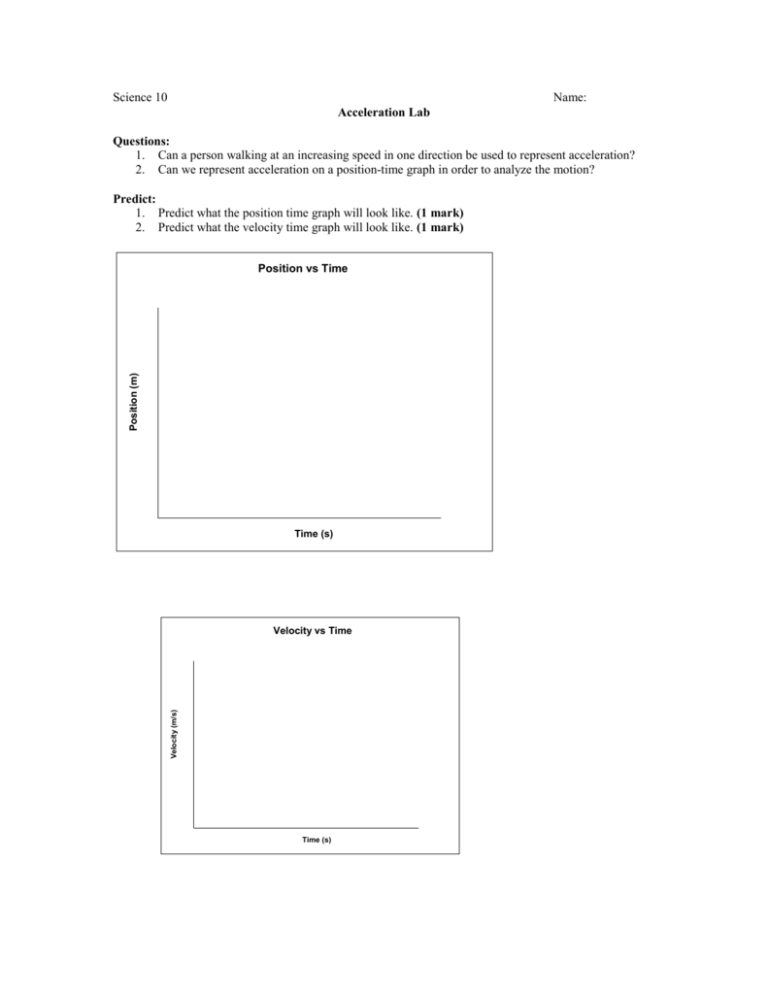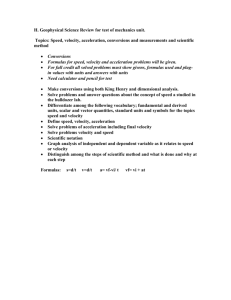Walking Speed and Acceleration Lab
advertisement

Science 10 Name: Acceleration Lab Questions: 1. Can a person walking at an increasing speed in one direction be used to represent acceleration? 2. Can we represent acceleration on a position-time graph in order to analyze the motion? Predict: 1. Predict what the position time graph will look like. (1 mark) 2. Predict what the velocity time graph will look like. (1 mark) (m) Time (s) (m/s) Velocity vs Time Velocity (m/s) Position (m) Position vs Time Time (s) Materials: Metric tape measure, stopwatch, graph paper Procedure; Uniform Motion (Constant Speed) Activity 1. You will need 6 people per group to measure each person’s attempt to accelerate over the 25 m course. 2. Use the tape measure and masking tape to measure out a 25 m straight line. Mark a starting point as ‘0’ and marks at 5, 10, 15, 20 and 25 metres. 3. Each student with a stopwatch and will stand five metres apart in a straight line. 4. When ready, the walking student will give a signal, and ALL those with stopwatches will start timing. As the walking student passes a stopwatch station, the person timing will stop their clock and record the total time (in seconds). TRY FOR A CONSTANT ACCELERATE. 5. After completing the walking course, the walking student should record their times on the data table provided. 6. Repeat this procedure for each person in your group. Data Table: Time (s) 0s Distance (m) 0m 5m 10 m 15 m 20 m 25 m Graph your Results: 1. Plot a Position vs. Time graph with the distanced traveled on the Y (vertical) axis and the time on the X (horizontal) axis. Make sure your x and y-axes are labeled correctly. Please remember to include units while labeling the axes. (4 marks) 2. Draw a smooth line that connects as many data points as possible. This is called a best fit line and is used to help ‘smooth’ out the experimental (measuring) error. This line should be a curve as velocity increase. (1 mark) Discussion Questions: 1. What does the line of best fit ‘tell’ you about your data? (1 mark) 2. Study the position time graph and the velocity graph of uniform motion (constant velocity with zero acceleration) below. Compare it to the non-uniform motion or acceleration graph. Uniform Motion (constant velocity) Non Uniform Motion (acceleration) Predict what you think the velocity time graph will look like for an object that is accelerating in the positive direction. Draw your prediction on the acceleration velocity time graph. (1 mark) What to Do 3. Study the data table below. 4. Calculate the change in velocity for each of the following time intervals. Let the forward direction represent positive (+) velocity. Calculate change in velocity with the following equation: a) 0 s -20 s (1 mark) b) 20 s - 40 s (1 mark) c) 40 s - 60 s (1 mark) d) 60 s - 80 s (1 mark) e) 80 s - 100 s (1 mark) What Did You Find Out? 5. During which of the 20 s time intervals was the object speeding up? (1 mark) 6. During which of the 20 s time intervals was the object slowing down? (1 mark) 7. During which of the 20 s time intervals was the change in velocity zero? (1 mark)





